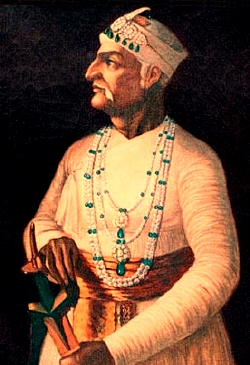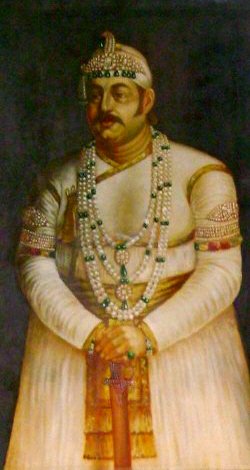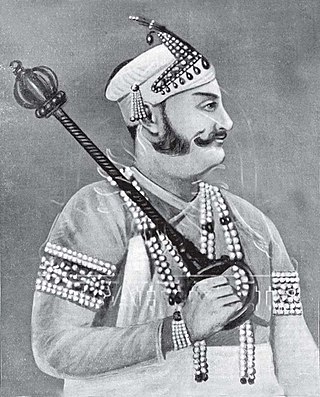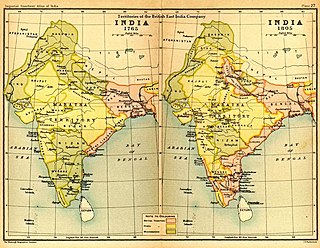
Bajirao I, born as Visaji, was the 7th Peshwa of the Maratha Confederacy.

Hyderabad State was an independent monarchy/princely state located in the south-central Deccan region of Indian Subcontinent with its capital at the city of Hyderabad. It is now divided into the present-day state of Telangana, the Kalyana-Karnataka region of Karnataka, and the Marathwada region of Maharashtra in India.

Mir Qamar-ud-din Khan Siddiqi also known as Chin Qilich Qamaruddin Khan, Nizam-ul-Mulk, Asaf Jah and Nizam I, was the first Nizam of Hyderabad. He was married to the daughter of a Syed nobleman of Gulbarga. He began his career as a favourite of the Mughal emperor Aurangzeb, who made him a general. Following the death of Aurangzeb in 1707, Asaf Jah refused to favour any one of Aurangzeb's warring sons and as such remained neutral. When Aurangzeb's third son Bahadur Shah ultimately emerged victorious, Asaf Jah was rotated as governor of multiple Mughal provinces until 1714, when he was created Viceroy of the Deccan with authority over six Mughal provinces in southern India from 1714 to 1719. From 1719 onwards he was involved in combating the intrigues of the Sayyid Brothers. From 1720 to 1722 he helped the new Mughal emperor Muhammad Shah eliminate the Sayyed brothers and was rewarded by being elevated to the grand viziership from 1722 to 1724. He also engaged in military conflict against Bajirao I in Battle of Palkhed and Battle of Bhopal in which he was severely defeated and had to sue for peace.

Aurangabad, officially known as Chhatrapati Sambhaji Nagar, or Chhatrapati Sambhajinagar, is a city in the Indian state of Maharashtra. It is the administrative headquarters of Aurangabad district and is the largest city in the Marathwada region. Located on a hilly upland terrain in the Deccan Traps, Aurangabad is the fifth-most populous urban area in Maharashtra after Mumbai, Pune, Nagpur and Nashik with a population of 1,175,116. The city is known as a major production center of cotton textile and artistic silk fabrics. Several prominent educational institutions, including Dr. Babasaheb Ambedkar Marathwada University, are located in the city. The city is also a popular tourism hub, with tourist destinations like the Ajanta and Ellora caves lying on its outskirts, both of which have been designated as UNESCO World Heritage Sites since 1983. Other tourist attractions include the Aurangabad Caves, Devagiri Fort, Grishneshwar Temple, Jama Mosque, Bibi Ka Maqbara, Himayat Bagh, Panchakki and Salim Ali Lake. Historically, there were 52 Gates in Aurangabad, some of them extant, because of which Aurangabad is nicknamed as the "City of Gates". In 2019, the Aurangabad Industrial City (AURIC) became the first greenfield industrial smart city of India under the country's flagship Smart Cities Mission.

Mirza Nasir-ud-Din Muḥammad Shah was the thirteenth Mughal emperor from 1719 to 1748. He was son of Khujista Akhtar, the fourth son of Bahadur Shah I. After being chosen by the Sayyid Brothers of Barha, he ascended the throne at the young age of 16, under their strict supervision.

Berar Province, also known as the Hyderabad Assigned Districts, was a province of Hyderabad. After 1853, it was administered by the British, although the Nizam retained formal sovereignty over the province. Azam Jah, the eldest son of the 7th Nizam, held the title of Mirza-Baig ("Prince") of Berar.

Nizam of Hyderabad was the title of the ruler of Hyderabad State. Nizam is a shortened form of Niẓām ul-Mulk, which means Administrator of the Realm, and was the title bestowed upon Asaf Jah I when he was appointed Viceroy of the Deccan by the Mughal Emperor Farrukhsiyar. In addition to being the Mughal Viceroy (Naib) of the Deccan, Asaf Jah I was also the premier courtier of the Mughal Empire until 1724, when he established the independent monarchy of Hyderabad and adopted the title "Nizam of Hyderabad".
The Treaty of Mungi-Shevgaon was signed on March 6, 1728, between Bajirao I of the Maratha Empire and the Nizam of Hyderabad, Asaf Jah I, in what is present-day Shevgaon. According to the terms of the treaty, the Nizam granted the Marathas the authority to collect Chauth, a type of tax, from the six Subahs located in the Deccan region. Additionally, the treaty recognized Shahu I as the Emperor of the Maratha Empire, and in return, the Maratha Emperor agreed not to apprehend Sambhaji II, who had allied himself with the Nizam against the Emperor.

Mirza Nizam Ali Khan Siddiqi, Asaf Jah II was the 5th Nizam of Hyderabad State in South India between 1762 and 1803. He was born on 7 March 1734 as fourth son to Asaf Jah I and Umda Begum. His official name is Asaf Jah II, Nizam ul-Mulk, Nizam ud-Daula, Nawab Mir Nizam 'Ali Khan Siddiqi, Fateh Jang, Sipah Salar, Nawab Subedar of the Deccan. Sawānih-i-Deccan, a Persian work compiled by Munim Khan, a military commander during the era of Asaf Jah II gave more insight about administration of Asaf Jahis.

Afzal ad-Dawlah, Asaf Jah VMir Tahniyat Ali Khan Siddiqi was the ruling Nizam of Hyderabad, India, from 1857 to 1869.

The Berar Subah was one of the Subahs of the Mughal Empire, the first to be added to the original twelve, in Dakhin from 1596 to 1724. It bordered Golconda, Ahmandagar, Kandesh and Malwa subahs as well as the independent and tributary chiefdoms to the east.

The Asaf Jahi was a Muslim dynasty that ruled the Hyderabad State. The family came to India in the late 17th century and became employees of the Mughal Empire. They were great patrons of Persian culture, language, and literature, and the family found ready patronage.

The Siege of Trichinopoly was part of an extended series of conflicts between the Nizam of Hyderabad and the Maratha Empire for control of the Carnatic region. On 29 August 1743, after a six-month siege, Murari Rao surrendered, giving Nizam ul Mulk (Nizam) the suzerainty of Trichinopoly. By the end of 1743, the Nizam had regained full control of Deccan. This stopped the Maratha interference in the region and ended their hegemony over the Carnatic. The Nizam resolved the internal conflicts among the regional hereditary nobles (Nawabs) for the seat of governor (Subedar) of Arcot State, and monitored the activities of the British East India company and French East India Company by limiting their access to ports and trading.
Ballari pronounced is a historic city in Bellary district in Karnataka state, India.
Hyderabad was the capital of the Indian states of Telangana and Andhra Pradesh. It is a historic city noted for its many monuments, temples, mosques and bazaars. A multitude of influences has shaped the character of the city in the last 400 years.

The history of Telangana, located on the high Deccan Plateau, includes its being ruled by the Satavahana Dynasty, the Kakatiya Dynasty (1083–1323), the Musunuri Nayaks (1326–1356), the Delhi Sultanate, the Bahmani Sultanate (1347–1512), Golconda Sultanate (1512–1687) and Asaf Jahi dynasty (1724-1950).
Rajahmundry Circar or Rajahmundry Sarkar was one of the five Northern Circars in the Golconda Sultanate, Deccan subah of Mughal empire and later in the Nizam's dominion of Hyderabad. The Northern Circars were the most prominent ones in the Deccan subah. Eastern Ghats near Pentakota village were considered the northern limit of the Rajahmundry Circar while the southern limit was demarcated by the Godavari river.
Sawānih-i-Deccan was a work was compiled by Munim Khan al-Hamdani al-Aurangabadi in 1197 A.H.. It is an unpublished manuscript in Persian and gives statistics of revenue accounts of the six subas of the Deccan with a historical account of the Asaf Jahis or Nizams of Hyderabad. Munim Khan was a military commander during the regime of Asaf Jah II. This work gave more insight about the regime of Asaf Jahis between 1724 A.D. and 1783 A.D. It also describes the administrative divisions and revenue of the Mughal Deccan during the last years of Aurangzeb's regime. A detailed list of Sarkars, Mahals (Parganas) and Villages along with their revenue was mentioned.

Shams ul-Umara, Shams ul-Mulk, Shams ud-Daula, Nawab Muhammad' Abu’l Fath Khan Bahadur, Taigh Jang Bahadur ['Abu’l Khair Khan II] [Imam JungIII] was an Indian nobleman and founder of the House of Paigah.

The Maratha-Nizam wars (1720–1819) was a series of military conflicts between the Maratha Empire and the Nizam of Hyderabad, spanning nearly a century. These conflicts arose primarily from the Marathas' imposition of Chauth, a form of tribute, on the Nizam's dominions, leading to tensions and subsequent hostilities between the two powers. The Nizam's response to the Maratha demands sparked a series of clashes and wars aimed at resisting Maratha encroachment and asserting territorial sovereignty.

















